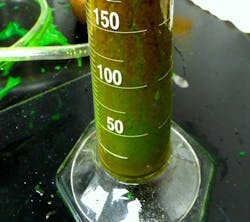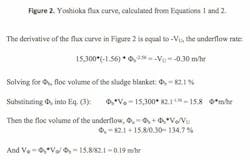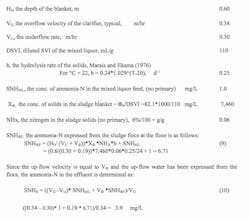Sludge Blanket Upflow
M. Truett Garrett is president of M.T. Garrett and Associates. Jeffery Farrell is Environment Inspector III for the City of Houston. Authors can be reached at [email protected].
undefinedMany times, city of Houston wastewater treatment plant (WWTP) operators have found effluent ammonia-nitrogen of several milligrams per liter in one or more clarifiers when other clarifiers were near zero. The cause of the presence of ammonia was not understood. These occasions increase the likelihood of a permit violation, so determining the reason they happen is important. On a visit to the city of Houston Sagemont WWTP, a 6-million-gal-per-day activated sludge facility, different ammonia-N values were found in the effluents of two adjacent final clarifiers receiving the same mixed liquor.
The data indicates that the ammonia-N came up out of the sludge blanket, but how?
Figure 1
In the evaluation of one-dimensional modeling of secondary settling tanks by Li and Stenstrom (2014) there is no mention of upflow water in the thickening zone (below the inlet). In a review of thickening (in mining and metallurgy) in the 20th century Concha and Bürger (2003) do not mention the upflow of water in the thickening zone. Loeffler (1953) studied the settling of glass spheres and described the settling process as follows: “If the cloud of particles is contained in a vessel… the net liquid flow and exerted force must be upward. This is true since a downward flow of solids causes an upward flow of liquid by displacement…. This liquid velocity added to the velocity of sedimentation then gives the relative, or slip velocity between spheres and liquid…” and for fluidization the slip velocity is the same, since the net velocity of the particles relative to the container is zero. Many tests of sedimentation and fluidization of suspensions of glass spheres showed the results for the same suspension were almost identical. The fluidization slip velocities were measured, but the slip velocity in sedimentation was only determined by logic.
The rate of upflow of water given by Skilling (2001) is identical to the rate of settling given by Coe and Clevenger (1916); therefore, with reference to the vessel wall, the upflow rate is equal to the settling rate. Since the logic of Loeffler is unused by so many scholars additional evidence is provided to help the understanding of the matter and to develop a model.
In order to find if water flows upward through the sludge blanket, color was introduced to the bottom of a settling test. A dye was added to a portion of mixed liquor, and then 10 mL of the dyed portion was pipetted to the bottom of the same mixed liquor in a 500-mL graduated cylinder at the start of the test. (The cylinder was not filled to the 500-mL mark.)
After five minutes, settling colored water was observed rising not only in channels, but also throughout the bottom 125 mL of mixed liquor, as shown in the photo above. The rising colored water illustrates the logic of Loeffler.
Figure 2
Michaels and Bolger (1962) and Scott (1968) discussed the settling of solids as flocs of flocculated particles. And as there was no mention of mixing of the water within the flocs with the water surrounding the flocs, the observation of green water flowing between the flocs may be considered to be in agreement with the presentations of Michaels and Bolger and of Scott.
This sets the approach to modeling the return of sludge products to the effluent. The products of sludge metabolism remain in the sludge flocs until expressed from them as the solids concentration changes the underflow concentration near the tank bottom. The expressed water rises through the sludge flocs without mixing until it reaches the water above the sludge blanket, then mixing and exiting with the effluent. This explains the extra ammonia-N in the effluent of the second clarifier.
The model considers that all the upflow water comes from the bottom, where water is express to form the underflow solids concentration. The additional ammonia-N (PO4-P and biochemical oxygen demand) in the effluent can be calculated using information in Figure 1 and Figure 2.
Reactions within the flocs are the same as in reactive settling models, according to Bürger et al (2016). For only the concentration of ammonia-N at the bottom of the sludge blanket, you require the selection of the following values, measured or typical for Sagemont (see Figure 3).
Figure 3
Thus, the model calculation produces the same ammonia-N concentration as found at the facility,
The upflow of water through a sludge blanket does not affect the validity of the sedimentation model’s prediction of blanket formation, but if the report also discusses the friction on sludge flocs settling, it is necessary to have the water going in the proper direction.
The city of Houston Wastewater Operation Division has long had a policy of operating without a sludge blanket in the final clarifiers. However, if one wishes to minimize return sludge pumping cost, Garrett (2016) presents a spreadsheet program for calculating blanket formation and effluent ammonia-N from a sludge blanket.
The experiment and photograph affirm the logic of Loeffler that rising water occurs in hindered settling and explains the source of the higher ammonia-N in the effluent of the clarifier with a sludge blanket. A model is presented, and a reference is given to a free spreadsheet for the calculation of ammonia-nitrogen in the effluent.
Editor’s note: Citations for this article are available on request by emailing [email protected].



